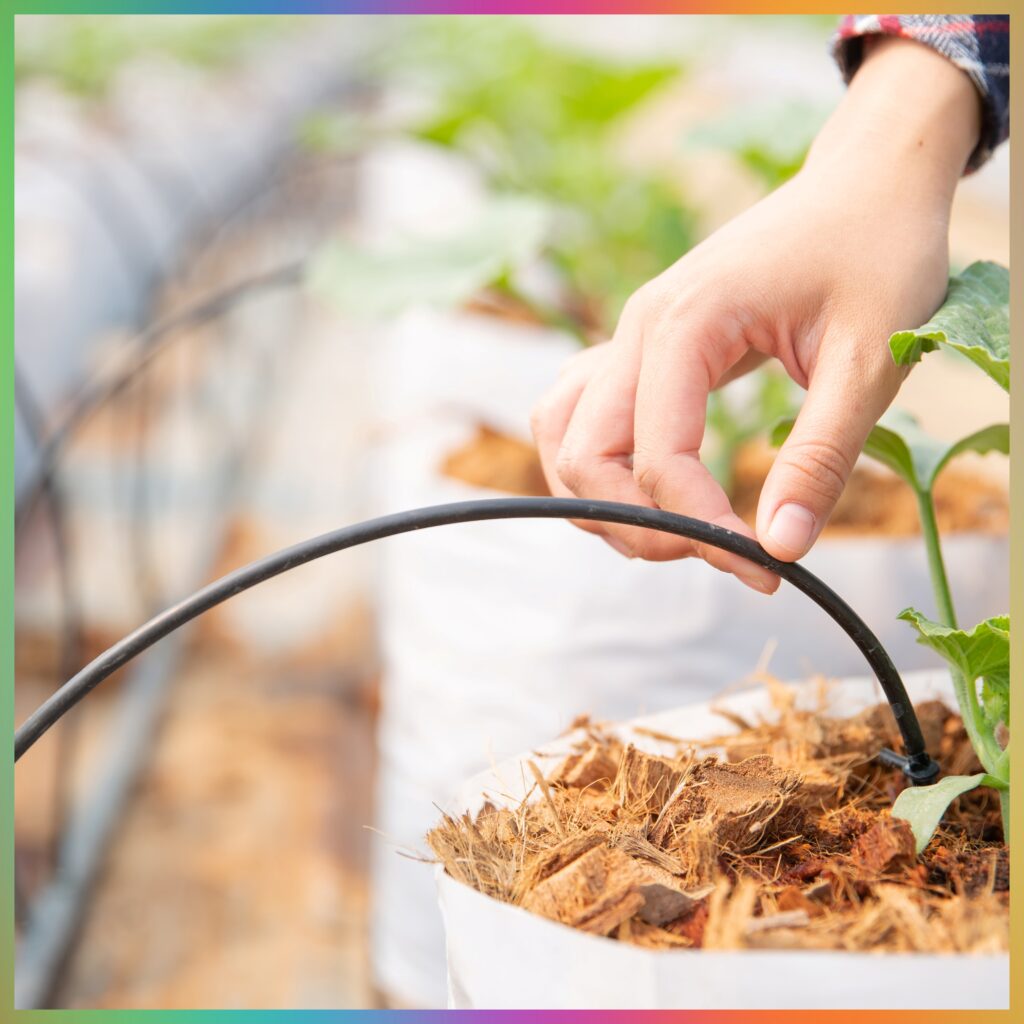
Watering flower beds can be quite challenging.
Since flower beds depend on irrigation, choosing the right irrigation system is crucial for maintaining healthy, vibrant plants. The ideal irrigation system provides consistent moisture to the root zone without overwatering, preventing issues like disease, nutrient deficiencies, and soil erosion.
Before selecting an irrigation method, it’s essential to consider factors like installation requirements, maintenance needs, and costs. Based on these factors, here are the best irrigation systems for flower beds.
Drip Irrigation

Undoubtedly, drip irrigation is best suited for flower beds due to its low water usage, easy setup, and minimal maintenance.
In drip irrigation, water is delivered drop by drop via narrow tubes or tape with emitters built inside at fixed distances.
You can set up drip irrigation for large and small lands and can even customize using sensors and emitters.
By wetting only the soil, it prevents fungal diseases caused by moisture sitting on leaves and flowers. The slow and deep application of water encourages stronger root growth. Compared to sprinklers, drip irrigation systems significantly reduce water loss due to evaporation or runoff.
And maintenance is relatively minimal, primarily involving checking for clogged emitters and replacing them if necessary. Additionally, the parts for drip irrigation are inexpensive to replace.
Soaker Hose
Soaker hose is a long porous hose leaking water, and is a great choice for flower beds.
This system doesn’t require any motor or any special equipment to irrigate. Just connect to a spigot or a water source, and they slowly emit water to soak soil and roots along the hose span.
This method is well-suited for flower beds’ moderate watering needs. Installation involves laying the hose along the edges or contours of the flower bed and connecting it to a faucet or splitter for water flow control.
Maintenance is also too low. You just need to disconnect and store the hose to avoid winter damage and draining and provide consistent water dispersal soaker hoses to minimize puddling issues from sprinklers.
The downside of the soaker hose is leaks and clogs, which are tricky to locate. Periodic hose replacement may be necessary, and precautions should be taken against animals, like rodents, that may chew on hoses. Careful regulation of water pressure is essential to avoid variable discharge rates, especially in large gardens where multiple hoses might be required, potentially creating a messy appearance.
Overhead Irrigation
Overhead Irrigation is the other most suitable method for flowers, especially if you’re growing them in a greenhouse.
In Overhead Irrigation, various types can be used, such as sprinklers, misting, etc.
Overhead Irrigation is easy to install and maintain, suitable for hot and arid climates. Since there are no hoses in the garden beds, it is easy to weed using a hoe or tool.
However, the drawback of this method is that it can promote fungal diseases in plants and weed growth because it waters everything, including aisles.
Micro Sprinklers
Micro sprinkles are suitable irrigation for the flower beds, covering small areas with effective watering.
Micro sprinklers come in various types, including rotating, misting, pulsing, bubbles, and many more, making them suitable for small flower beds.
The benefits of the sprinkler are the ability to cover widespread areas and configure precision spray patterns for water distribution uniformity. But to achieve this sprinkler placement, spacing and pressure requires careful planning to limit issues like watering sidewalks or uneven application leading to dry spots.
The downside if the system is installed is complex and requires periodic checks for broken heads or pipes, head adjustment, and winterization in cold climates by blowing compressed air through lines.
Rainwater Harvesting and Water Butts
Using rainwater harvesting and water butts is the effective method used for flower beds.
You can consider the suitable irrigation system attached to this setup.
Rainwater harvesting not only reduces water bills but also helps minimize the amount of water you use. It enables you to recycle water that would have otherwise gone down the drain, allowing you to contribute to environmental conservation.
These are all the irrigation systems suitable for flower beds. However, before choosing one, consider some key factors.
Key Consideration
It is best to choose the irrigation system by considering facts like soil type and drainage, sun exposure, climate, water restrictions, plant types, and layout and budget.
For example, small irrigations work well in hot, dry climates to combat evaporation but increase disease risk in cool, humid environments. Gardens on slopes may require drip irrigation with check valves to prevent low point flooding. Shady beds and containers demand more precision watering than uniform lawns and solar exposures.
Also, consider the budget and have a long-term view. For instance, drip irrigation requires a greater upfront investment, but its efficiency can lead to longer-term water savings over sprinklers. Meanwhile, soaker hoses provide the most economical option for smaller gardens.
Automation and sensor installation can save water but add more expenses. Consider wiring needs for electrical components too.
Professional design and installation is recommended for complex landscapes but can inflate budgets. Doing prep work like planning and trenching digging yourself saves on labor.
Final Thoughts…
When installing an irrigation system, ensure compliance with local regulations. In my experience, I outsourced the installation and paperwork for an automatic sprinkler system on my farm. Whether you hire a professional or do it yourself, acquiring adequate knowledge is essential.
Additionally, manual watering should still be used for potted plants or delicate flowers requiring special attention. Relying solely on irrigation reduces opportunities for regular plant inspections, which are vital for early disease detection and plant care.
By carefully selecting and properly managing an irrigation system, you can maintain a thriving flower bed while conserving water and minimizing maintenance costs.

Leave a Reply